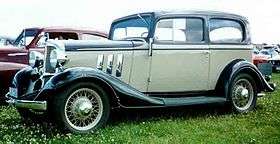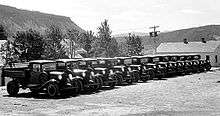Chevrolet Eagle
The Chevrolet Eagle (Series CA) is an American vehicle manufactured by Chevrolet in 1933 to replace the 1932 Series BA Confederate. The Eagle was produced early in the 1933 production year. When it was joined by the cheaper Mercury later in 1933 the Eagle name was changed to Master to provide Chevrolet with a two-car range, and the first time in ten years they manufactured two models on different wheelbases. The Mercury was also known as the Standard series. [1]
| Chevrolet Eagle and Master | |
|---|---|
 | |
| Overview | |
| Manufacturer | Chevrolet (General Motors) |
| Also called | Eagle and Master Series CA / Mercury or Standard Series CC |
| Production | 450,435 (Eagle and Master) 35,845 (Mercury or Standard) |
| Model years | 1933 |
| Assembly | Oakland Assembly, Oakland, California North Tarrytown Assembly, Tarrytown, New York Flint Assembly, Flint, Michigan Norwood Assembly, Norwood, Ohio St. Louis Assembly, St. Louis, Missouri Oshawa Assembly, Oshawa, Ontario Canada Osaka Assembly, Osaka, Japan General Motors South Africa, Port Elizabeth, South Africa GM Argentina, Buenos Aires, Argentina GM Belgium, Antwerp, Belgium |
| Body and chassis | |
| Layout | FR layout |
| Platform | GM A platform |
| Related | Chevrolet Mercury Chevrolet Suburban |
| Powertrain | |
| Engine | 206 cu in (3.4 L) 6-cylinder |
| Dimensions | |
| Wheelbase | 110 in (2,794.0 mm) |
| Curb weight | 2,675–2,880 lb (1,213–1,306 kg) |
| Chronology | |
| Predecessor | Chevrolet Series BA Confederate |
| Successor | Chevrolet Master and Standard |
Total the earlier Eagle and later Master combined sold 450,435 vehicles, an increase of nearly 140,000 the previous year's Series BA sales of 313,395, and ensured that Chevrolet was able to retain their number one spot in American car sales. The Eagle saw the end of two-seater cars from Chevrolet, and the new Town Sedan included an integral trunk.
There are several differences between the Eagle and Master. The easiest to identify is the post between the front door wing windows and the roll down windows. On the Eagle the chrome divider between these two windows goes down as the window goes down, where as on the Master this divider remains fixed and does not go down with the window.
Specification
The Eagle and Master's wheelbase increased an inch to 110 in (2,794.0 mm) compared to the Series BA, and was three inches longer than the new Mercury.
It was powered by a larger version of the "Stovebolt Six", 206 cu in (3,380 cc) six-cylinder engine, producing 65 hp (48 kW).[2] A smaller 181 cu in (2,970 cc) six-cylinder was used in the Mercury, producing 60 hp (45 kW)
Trucks

GM also used the Eagle chassis and platform for trucks branded as both Chevrolet and GMC.
References
- Notes
- "1933 Chevrolet Eagle and Mercury". How Stuff Works. Retrieved 3 January 2013.
- "1933 Chevrolet Master Eagle Series CA Cabriolet". Bonhams. Retrieved 3 January 2013.
- Sources
GM Heritage Center 1933 Chevrolet Passenger car and Truck specifications
| Wikimedia Commons has media related to Chevrolet Master Eagle. |